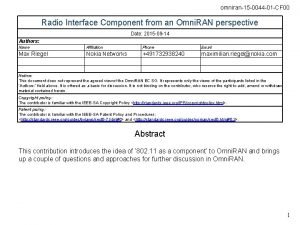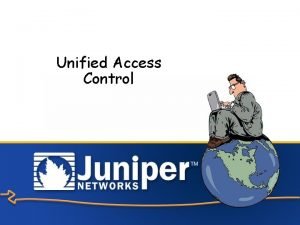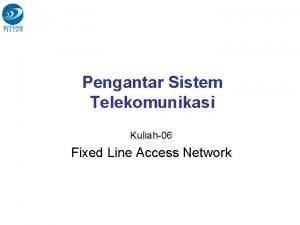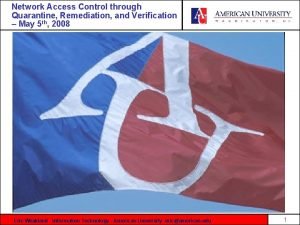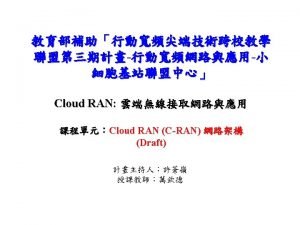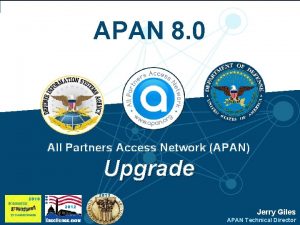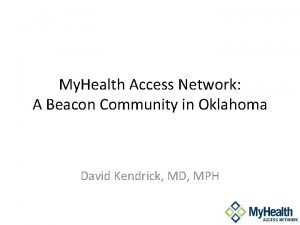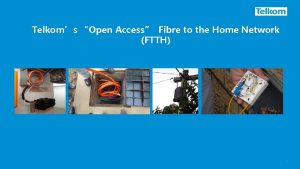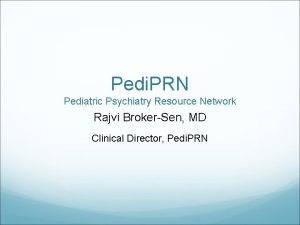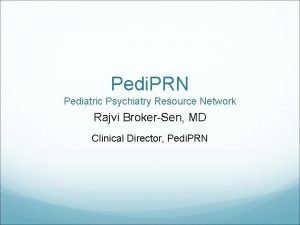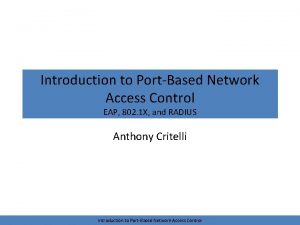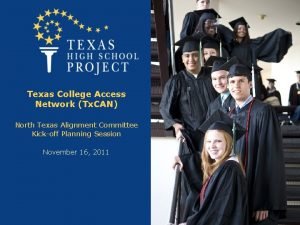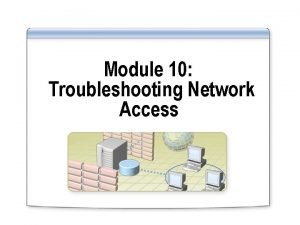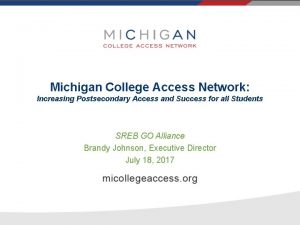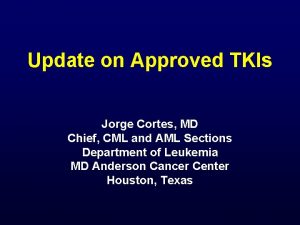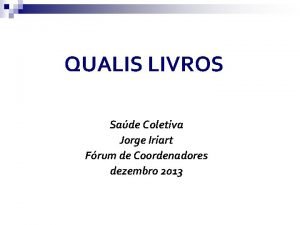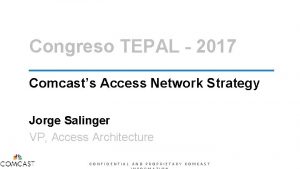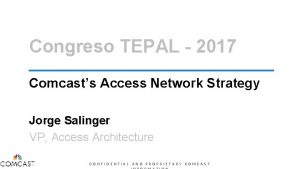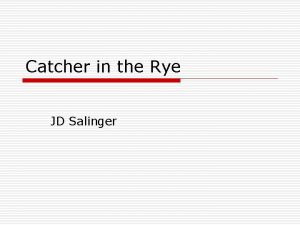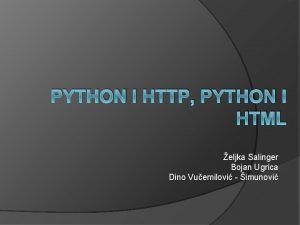COMCASTS NETWORK ARCHITECTURE Jorge Salinger VP Access Architecture





































- Slides: 37

COMCAST’S NETWORK ARCHITECTURE Jorge Salinger VP, Access Architecture jorge_salinger@cable. comcast. com

COMCAST’S ACCESS NETWORK STRATEGY • DOCSIS 3. 1 – Gigabit to 100% of homes • Fiber Deep HFC – N+0 and DAA – FDX and Virtualization • FTTP and multi-gigabit – 10 G EPON NG-EPON – Metro. E and residential • FTTH for all new construction – Master Architecture Plan – MDU and SDU 2

DOCSIS 3. 1 - Readiness Phases Network Readiness MPEG 4 Reclaim (<=750 MHz) OFDM Spectrum Availability RF Combining • CMTS HW and SW • Arris E 6000 • Cisco CBR 8 w/ Gemini II • • Licenses Power & Equipment Narrowcast Lasers CIR impact reporting (Haystack) Installation Tool CPE Readiness Q 2 – Retail Cable Modem • Cable. Labs Certified • TQM DOCSIS testing • Limited field testing • ACEA tool updated • Field Advisory • My. Device Info Q 3 (August) – XB 6 • TQM DOCSIS, Voice, Wi. Fi & feature testing • Tech, Employee & Customer trial complete • Scout/Einstein/My Account support Product Readiness Systems Readiness • D 3. 1 supported by network tools D 3. 1 Tech, Employee & Customer trials complete D 3. 1 speeds & signals validated Launch activities • OFA for new speed tier & rate codes • Speed Test Server Upgrade • Sales Approach • GTM Plan • Agent Training • Field Ops Training 1 GB Launch

Spectrum Allocation and Capacity • • Downstream – Deploy D 3. 1 DS in available spectrum and bond with D 3. 0 DS channels – Plan: 24 D 3. 0 SC-QAMs + 96 MHz D 3. 1 OFDM ≈ 900 Mbps + 800 Mbps – Establish 1 Gbps tier from 1. 7 Gbps capacity, and expand from there – Reclaim spectrum as needed: Analog Digital MPEG-4 IP Video Upstream – Initially use D 3. 0 US capacity in current spectrum (maximize use of US) – When available, deploy D 3. 1 US in all spectrum via Ta. FDM of D 3. 0 US Legacy OOB US 3 -4 D 3. 0 Chan Legacy OOB DS Future Spectrum for DOCSIS 3. 1 Future DOCSIS 3. 1 5 MHz Upstream DOCSIS 3. 1 Upstream 16 -24 D 3. 0 . . . 42 54 MHz . . . Dig. Video . . . Downstream 4 -8 D 3. 0 Chan 5 MHz Dig. Video DOCSIS 3. 1 Dig. Video 16 -32 D 3. 0 . . . 85 102 MHz 750 MHz 860 MHz 1, 000 MHz Dig. Video . . . Downstream 4 Initial Spectrum for DOCSIS 3. 1 750 MHz 860 MHz 1, 000 MHz 1, 200 MHz

Started trial in Philly, and now also have DOCSIS 3. 1 in Atlanta, Fresno and Santa Rosa 5

DOCSIS 3. 1 deployments have begun ! • Originally targeting 3 Q 16 for DOCSIS 3. 1 deployments • However, given competitive pressures, started deployments in March with XM 6 -like cable modem – Atlanta, Nashville, Chicago, Detroit, Miami 6

Comcast’s Network Technology & Deployment Strategy 1. Business Drivers Technology Deployment § § 2. • Bandwidth Reclaim • Enables Asymmetrical- Gigabit speeds • Less Expensive CPE MPEG 4 /DOCSIS 3. 1 Deployment plan EPON – Enables Gbit+ Symmetrical Services Project GRAM – Evolution to an All IP Network X 1 Acceleration Fiber Deep (fiber to small neighborhoods ~100 HHP) § Target 50% of footprint by 2022 § Market Priority based on Competitive Exposure & Intensity 3. Fiber-to-the-Customer (FTTC) § § § 4. Success-Based Fiber Network Evolution Customer by Customer Enablement Head-End Capital ($15 M) Staff C-MAP Network Planning & Control Facilitates Commercial High-Bandwidth customers Leverages existing HFC long term + Customer Experience - net reliability Solid Penetration Asymmetrical Gigabit Improved Bandwidth – forward & return Lower OPEX (~$5 per HHP) • • Supports 2 Gbit product roll-out Expands Commercial FTTX Reach Long term network evolution strategy Logical network build & control function • • Enables Gigabit+ speeds Brownfield competition at house level Long term network evolution strategy Lower OPEX over time • • Fiber to the premise claims re ACN Capacity node split relief Fiber close to customer (2 putt) Solution to fend off small competitors Reorientation of Direct Sales Model Fiber-to-the-Home (FTTH) § All New Build, MDU & SFU § Enemy Trench & Construction Sharing via Municipalities & Gov’t Affairs § Contract Driven Properties – Limited & CHQ Approved 5. Fiber-to-the-Building in MDU’s (FTTB) § Supports ACN Branding & Initiatives § MDU Offload for Capacity Relief § EPON Overlay/Ethernet Switched Solution 6. Commercial Metro-Core Fiber Builds § Commercial Proactive Fiber Overlays in Major Metros (aka Philadelphia) 7 • • • 7 • Rapid growth of commercial footprint • Access to mid & large cap enterprise • Long term network evolution strategy

Why Fiber Deep? The 10+ Year Look An untenable level of node splits is emerging Initially driven by exhaustion of upstream capacity; later shifting to downstream ð Build Fiber Deep with Mid-Split upstream as fast as possible for long-term capacity relief and a straightforward path to FTTH The pace that FD can be built in practice leaves markets exposed to CAGR for many years The FD investment must be complemented: • Continue node splits – “Fiber Deep Only” – Explosive growth in splits – HSD product offering limited OR Note: ADI includes cost of subsequent node splits • Complement with Active Drop-In – “Fiber Deep + ADI” – More cost effective (defers and reduces node splits) – Provides a platform for a consistent HSD product 8 DOCSIS 3. 1 is our predominant long-term capacity, speed, and IP transition technology

Distributed Architecture (DAA) is Key to Fiber Deep • HFC Network Benefits • Maximum Capacity of DOCSIS 3. 1 • Simplification of digital fiber and Ethernet vs AM • Fiber Efficiency of Digital Optics • More wavelengths and longer reach • Volume/cost curves of standardized digital optics • Facilities Scaling • Significant Space, Power and Cooling efficiencies • Alignment to NFV/SDN Initiatives • “DAA fo PON” needed for HFC infrastructure • Virtualization CCAP Core is the objective

Options for Distributed Access Architecture 1. Digitize in HE and regenerate in node (used for OOB, FM, etc. ) 4. Move entire PHY from HE to node 2. Mode DAC from HE to node 5. Move PHY and MAC from HE to node 3. Move lower PHY from HE to node 10 • Options 4 and 5 under vendor development • Could also miniaturize the CCAP (c. DOCSIS)

Remote Architectures Easily Deployed Headend 1. Deploy Linecard in HE any time 2. Migrate HFC node to DN during CM window CCAP DN Provides all broadcast and narrowcast services Same SM fiber § § 11 Maximize service group size Minimum changes in HFC network to start

Digital Node Segmentation Headend Same port for multiple DNs Segment a DN without using additional fiber DN CCAP DN Provides all broadcast and narrowcast services Same SM fiber DN § § 12 Evolve to smaller service group size as needed Simple evolution to add narrowcast capacity – Reuse fiber to headend – Leverage common broadcast

Simple and Scalable Migration Slow gradual migration, or sudden to end state, or anywhere in between. Scalable migration is key 13

The Road to Virtual CCAP • Remote PHY hardware for DS and US (RPD) – Could be centralized or distributed • Other CCAP components can be virtualized (CCAP Core) • Will need big SW concepts: SDN and Orchestration • And many things will be different, once again – More complex testing, integration and maintenance • But, we will get much higher feature velocity – Will we have agile network implementation sprints? 14

Consideration of Full Duplex • Key dependencies are ALL Po. R ü Passive Coax architecture (i. e. Fiber Deep) ü Distributed Architecture ü Transition to All-IP ü DOCSIS 3. 1 deployment plan • Objectives ‒ Service capability parity with FTTH ‒ Service evolution, provisioning, mgmt agnostic to last mile technology (All-IP) ‒ Integrate ASAP with FD DAA deployments

Potential of Full Duplex DOCSIS • Significantly more US capacity – Enable very high-capacity symmetrical data services • No need to move the split to expand US – Keep existing services in the low part of the spectrum • Backwards compatible with deployed DOCSIS – Upgrade on a success basis, keeping other devices • Existing technology, now applicable to HFC – Previously considered, but now seemingly feasible 1

Now in Detailed Feasibility Stage • Still in the early stages of technical development – Investigating Full Duplex DOCSIS for about 1 year – Discussions now expanding to a dynamic group • Applicable to certain HFC network topologies – Passive networks, best for distributed architectures • Key areas under investigation – Implementation of noise cancelling and applicability – Typical passive plant characteristics and requirements – Interoperability with existing DOCSIS 3. 0/3. 1 modems 1

Brownfield FTTP Planned Enablement • Success-Based Build Out 3 • Sequenced to enable entire footprint 1 2 • Deployment prioritized by demand clusters • Quick and broad availability • 10 G EPON technology 18

FTTP CHRONOLOGY • May 2014: FTTP Plan Established • June-July 2014: First two FTTU Properties (RFo. G installs begin - now BAU) • August 2014: 10 G EPON Direction Selected 19

FTTP CHRONOLOGY • October 2014: MDU FTTP Design & Construction Guidelines Draft Available • November 2014: 1 st Gig Message Launched (ACN) at NMHC Show • Nov ‘ 14 – Jan ‘ 15: Divisional Sales, Marketing, AE Training on Gigabit and ACN 20

FTTP CHRONOLOGY • Feb 2015: All-IP / EPON Project Kick-off • March 2015: 1 st PON Installation begins (trial) • April 2015: 2 Gig Symmetric (Gigabit Pro) Announced 21

FTTP CHRONOLOGY • May 2015: 1 st PON Bulk deal win (Naples, FL) • June 2015: Successbased FTTH investment / network (MMAP) 22

FTTP CHRONOLOGY • September 2015: First paying PON customers turned up (HFC + PON HSD) “The Esplanade, ” Naples, Florida • 2016: Many more deployments moving forward 23

10 G/10 G EPON SELECTED • Lead competition, not follow • Emerging technology over legacy • Support wide scale symmetric service tiers: 100/100, 300/300, 1000/1000 • Enable Multi-Gbps – Growth beyond 1 G • Match DS capacity of future HFC • Take advantage of DPo. E and integration experience • 10 G is a cost over reach for small overbuild competition • 10 G cost curve stimulated • Supports high penetration of 1 G speeds • Ability to drive NG EPON timeline aligned to our needs Comcast National Capacity Planning 24 Proprietary and Confidential Information 24

PON ARCHITECTURE COMPONENTS FOR CABLE 25

GRAM: ALL-IP CONTENT DELIVERY 2014: HYBRID QAM / IP INTRODUCTION XG 1 QAM ALL CHANNEL IP ENCODING IP HYBRID QAM / IP VOD TO XI 3 Xi 3 CLOUD DVR IP CDVR TO 2 ND SCREEN ENTIRE VOD LIBRARY IN IP IP DELIVERY 2015: START IP UNICAST LINEAR, VOD & CDVR XB 3/XB 6 TO ANY SCREEN Xi 3/Xi. D IP EPON deployment is more reliant on rapidly transitioning to all-IP delivery than the HFC network UNICAST IP TRIALS/ EARLY DEPLOYMENTS 2016: MULTICAST ALL-IP XB 6/XP 6 IP IP CHANNEL MULTICAST 26 Xi 5 ALL-IP GATEWAY

DO WE USE UNICAST OR MULTICAST? ANSWER: BOTH • Multicast reduces access network capacity for most popular content • Unicast used for all content not being multicasted • VOD and c. DVR • Long tail linear • Unicast is the back-up for reliable video delivery • Approach is transparent to all types of client players • Player is unaware of multicast • All players receive unicast • Multicast works for any client CDN Multicast Unicast MC Server/Controller CMTS Gateway MC GW Client Player 8. 00% Multicast Unicast 6. 00% 4. 00% 2. 00% 1 10 19 28 37 46 55 64 73 82 91 100 109 118 127 136 145 154 163 172 181 190 199 208 217 226 235 0. 00% 27

NETWORK CAPACITY BENEFIT FROM MULTICAST Savings • Benefit starts with about 50 clients and is even bigger with 100 -200 • Significant savings from multicast just 20 most popular programs 28

IP VIDEO ON EPON/DPOE SYSTEMS DOCSIS OSS Servers DNS CM/GW MC Coordinator IPv 6 Host HFC Network CMTS IPv 4 Host DHCP TFTP MC Server MDC SNMP IPDR Syslog Time IPv 4 Host ONU/GW CDN IP Network MDC R OLT IPv 6 Host IPv 4 Host IPv 6 Host ODN Network IPv 4 Host Virtual CM (v. CM) DPo. E System Multicast works for both DOCSIS® and EPON/DPo. E networks In EPON, SG is smaller, so capacity benefit is greater in RAN 29 IPv 6 Host

NEXT GEN EPON – IEEE STANDARD • Phase 1: Industry Connections (not all projects) - DONE – Outcome was a long report outlining need – Took 1 year, approved in March, 2015 • Phase 2: Call For Interest - DONE – Defines interest to create a new standard – Took 1 interval, approved during July plenary • Phase 3: Study Group - DONE – Defines Objectives, Qualification Criteria & PAR – 25 G, 50 G and 100 G EPON • Phase 4: Task Force - Started in January ’ 16 - WIP – Task Force approved following November meeting – Project is called 802. 3 ca

Nielsen’s Internet Use Growth Rate: 50% Yo. Y Empirical data from almost 20 years has very well tracked this theory. However, it does not clearly differentiate peak speed growth from usage growth rate. Source: Nielsen Norman Group 31

Observed Usage Growth Rate: 40 -60% Yo. Y NG-EPON CFI Presentation (ngepon_cfi_R 19 - Slide 17) NG-EPON SG Presentation (ngepon-1509 -salinger-1 – Slide 5) 32

Offered Peak Speed Growth Rate: 50% Yo. Y NG-EPON ICAD Report (ng_epon_report – Figure 17) NG-EPON SG Presentation (ngepon-1509 -salinger-1 – Slide 8) 33

Peak Speed Growth Yo. Y Projection Year Peak Speed Projection 2014 1 Gbps (Actual) 2015 2 Gbps (Actual) 2016 3 Gbps 2017 5 Gbps 2018 7 Gbps 2019 10 Gbps 2020 15 Gbps 2021 22 Gbps 2022 33 Gbps 2023 50 Gbps 2024 75 Gbps 2025 >100 Gbps 34 10 G EPON Capacity No Longer Effective

NG-EPON Objectives and Process • We don’t need 100 G to start in 2019 • Everyone agrees that we should develop a scalable technology • The above objectives present significant challenges for the TF to tackle • As a team, we worked through Call For Interest and Study Group with a timeline in mind – We targeted CFI presentation and SG Objectives, Criteria and PAR to meeting dates 35

SUMMARY • • Gigabit has become a core service component DOCSIS 3. 1 is the primary platform for gigabit services All new construction is being implemented as FTTH 10 G EPON deployments for MDU and SDU Continue Metro. E commercial services in entire footprint Multi-gigabit services for residential and commercial subs Long-term architecture plan – – HFC evolution – Fiber Deep, DAA, Virtualization and Full Duplex Near-term, success-based FTTH deployment and Gig. Pro Long-term transition to FTTH throughout the footprint Support +10 -yr capacity and product expectations – NG-EPON • This is as exciting as it gets in access networks! Comcast National Capacity Planning 36 Proprietary and Confidential Information 36

Thank You !! Questions, Comments or Suggestions? Jorge Salinger VP, Access Architecture jorge_salinger@cable. comcast. com
 Access network architecture
Access network architecture Catcher in the rye facts
Catcher in the rye facts Teddy j d salinger
Teddy j d salinger Anastasia salinger
Anastasia salinger J. d. salinger biography
J. d. salinger biography David jerome salinger
David jerome salinger Terminal access controller access control system plus
Terminal access controller access control system plus Terminal access controller access-control system
Terminal access controller access-control system Juniper network access control
Juniper network access control Access network adalah
Access network adalah Nac remediation
Nac remediation Health access network
Health access network Simultaneous access in network
Simultaneous access in network Centralized radio access network
Centralized radio access network All partners access network
All partners access network Myhealth beacon
Myhealth beacon Open access fibre network
Open access fibre network National network of child psychiatry access programs
National network of child psychiatry access programs Radio access network
Radio access network National network of child psychiatry access programs
National network of child psychiatry access programs Port-based network access control
Port-based network access control Access control matrix
Access control matrix Texas college access network
Texas college access network Troubleshooting
Troubleshooting Michigan college access network
Michigan college access network Difference between virtual circuit and datagram networks
Difference between virtual circuit and datagram networks What is topology in computer
What is topology in computer Features of peer to peer network and client server network
Features of peer to peer network and client server network Network systems design using network processors
Network systems design using network processors Network centric computing
Network centric computing Packet switching vs circuit switching
Packet switching vs circuit switching Jorge cortes md
Jorge cortes md Jorge otilio avendaño estrada
Jorge otilio avendaño estrada Jorge mario gaviria hincapie
Jorge mario gaviria hincapie Jorge maldonado cabrera
Jorge maldonado cabrera San jorge donatello comentario
San jorge donatello comentario Jorge peydro aznar
Jorge peydro aznar Jorge iriart
Jorge iriart
